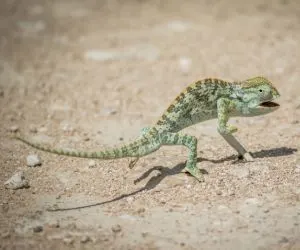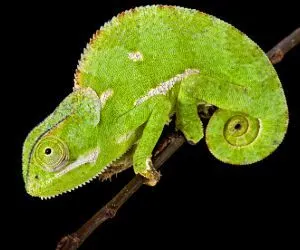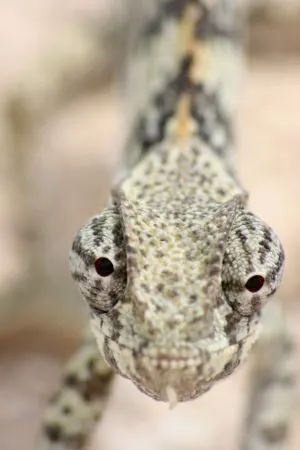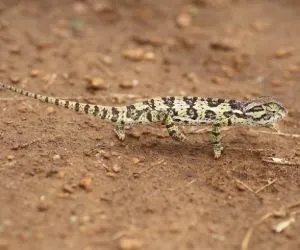Flap-necked Chameleons are an arboreal chamelon found in Sub-saharan Africa. There are a total of 8 subspecies or variants of this chameleon. Care for Flap-necked chameleons can be challenging, but they are pretty easy to find and make rewarding pets if you’re willing to put the time into caring for their needs.
Chameleons are a bit hard to care for in general since they have specific humidity and water requirements. You must do the proper research before even considering getting one.
We don’t recommend letting any children care for any chameleon alone, as they are not very child-friendly pets; their needs are not simple. An adult should be the one caring for this kind of pet and if a child is going to handle it, they must be supervised.
A lot of people find chameleons interesting due to their ability to change color, but not many people understand the concept or know why or how they can do so.
It’s a common misconception that they try to blend in with their surroundings in order to hide from predators, but that is actually not the case. In reality, chameleons will change their color to regulate their body temperature or communicate.
To maintain a favorable body temperature, chameleons will grow darker in color to absorb more heat in cold temperatures and will turn paler to reflect the sun’s heat in hotter temperatures. This is called thermoregulation.
They might be changing color to woo a possible mate, males might do it to signal at other males to stay away, and females might use their color change to show interest in mating.
So how do chameleons change color?
Under most chameleon’s transparent outer layer of skin sits two laters of specialized cells. The layer beneath the outermost layer contains chromatophores and the layer below that are guanophores, the second cell layer.
Chromatophores contain yellow and red pigments, whereas guanophores have a colorless crystalline matter we call ‘guanine’. Guanophores reflect the blue of incident light meaning that if the upper layer of chromatophores is yellow in color, the reflected light will be green.
They also have a layer of dark melanin-containing cells called melanophores located even deeper below the two layers of cells we just explained. These will influence the color and lightness of the reflected light.
Flap-necked Chameleon Facts

- Experience Level: Intermediate
- Scientific Name: Chamaeleo dilepis
- Alternate Name(s): Common African Flap Necked Chameleon, Flapneck Chameleon, Flap Neck Chameleon
- Family: Chamaeleonidae
- Size: 10 to 14 inches
- Diet: Insectivorous
- Lifespan: 5 to 8 years
- Where to buy: backwaterreptiles.com, flchams.com, reptmart.com
It is pretty simple to identify the sex of Flap-necks since the males will have a broader tail base and will also have an extra tiny spur at the back of their hind feet.
Subspecies list
- Chamaeleo dilepis dilepis Leach, 1819 – flap-necked chameleon
- Chamaeleo dilepis idjwiensis Loveridge, 1942 – Idjwi Island flap-necked chameleon
- Chamaeleo dilepis isabellinus Günther, 1893 – Isabelline flap-necked chameleon
- Chamaeleo dilepis martensi Mertens, 1864 – Pemba Island flap-necked chameleon
- Chamaeleo dilepis petersii Gray, 1865 – Peters’ flap-necked chameleon
- Chamaeleo dilepis quilensis Bocage, 1866
- Chamaeleo dilepis roperi Boulenger, 1890
- Chamaeleo dilepis ruspolii Boettger, 1893
Flap-necked Chameleon Appearance

Flap-necked Chameleons can range from various shades of greens, yellows, and sometimes even browns. Although, they will typically be green.
They can vary in color and are not limited to these colors and can turn black or even bright pink, depending on their mood and purpose at the moment. Their typical green shades mean they are relaxed whereas darkening shades might be due to stress or simply regulating temperatures.
This species has the ability to open some chromatophores that allow them to create patterns such as stripes, spots, or dots. Their markings will typically be cream in color, but can also be pale yellow, brown, or black.
They get their name from their tiny, sometimes thorny-looking flap that trails from under their chin down their neck. From a distance, it resembles a little lime-green flap that hangs below their chin.
Flap-necked Chameleon Location and Natural Habitat
This species is native to sub-Saharan Africa and remains the only endemic species in Botswana as well as other parts of this species’ range. Although, due to commercial farming and mining, they are starting to become restricted for distribution due to these activities.
They enjoy inhabiting dry or moist savannahs, coastal thickets, woodland, and forests where they climb, spending their days in the treetops of these environments.
Flap-necked Chameleon Diet

Flap-necked Chameleons are insectivores and their favorite bugs seem to be grasshoppers and beetles in particular.
Various reptiles possess the Jacobsen’s organ, which is right under their noses and gives them the ability to detect chemical particles. In chameleons, however, this organ is a lot more reduced in its ability to smell. This leaves them to use their other senses when catching their prey.
Since chameleons do not hear very well, they will use air vibrations and low-pitched noises to figure out where their prey is.
When prey is in sight, they catch it by first focusing their binocular-like eyes on their target, then shooting their sticky tongue out of their mouth to grab it. This species has a tongue the size of its whole length.
Flap-necked Chameleon Lifespan
The Flap-necked Chameleon is estimated to live a lifespan of around 5 to 8 years.
They can live longer in captivity than they would in the wild if they are cared for properly. Otherwise, they will have a shorter lifespan with inexperienced keepers.
Flap-necked Chameleon Breeding Habits
Egg development takes 3 – 4 months. The female becomes bloated with 25 – 50 small eggs; she lays her eggs in summer. The eggs may take 377 days to hatch in the wild.
The Jacobson’s organ, which we just mentioned in the last section, is also used for communicating readiness for mating between the same species through the release of chemical messages.
If you are attempting to mate your chameleons, it is important that you remove the male as soon as copulation is completed because the female is highly likely to attack the male right after mating.
Flap-necked Chameleons typically have a clutch size of around 25 to 50eggs per clutch about 1 to 3 times per year. Egg development may take 3 to 4 months.
Incubation may take anywhere from 10 months up to a year for this species and you want to incubate the eggs in vermiculite or damp peat at temperatures around 82 to 83 degrees Fahrenheit.
Predators of the Flap-necked Chameleon

Common predators of chameleons in these areas mostly include birds, snakes, as well as other mammals such as monkeys.
Flap-necked Chameleon Legality
Most chameleons are illegal to take from the wild, especially those classified as a Prohibited Dealing animal under the Biosecurity Act 2015, specifically listing Veiled Chameleons, Panther Chameleons, Jackson’s chameleons, and other common chameleon species.
However, most are allowed to be kept as pets, bred, and sold in all states except Maine as long as you have a permit, also known as CITES papers.
Where to Buy Flap-necked Chameleons
It is important that you find captive-bred chameleons because most wild-caught chameleons will, unfortunately, carry parasites and may also have stress-related illnesses. We recommend that you avoid getting a wild-caught chameleon.
It is crucial that you are doing your research and finding a reputable breeder or pet shop. Take your time to watch its movements and actions before going through with the deal to make sure that it is a healthy chameleon.
Indicators of an unhealthy chameleon you might want to keep an eye out for are if it is refusing food, has excess mucus around its mouth or nasal passages, or cloudy eyes. These could be signs of infection or just an overall unhealthy lizard.
You should also check for signs of dehydration by making sure their skin looks full and firm without any wrinkles or hanging excess skin.
You should also pay attention to their skin and color. If you see many dry patches, it could be an indicator that the breeder or shop is not taking care of them well or that the chameleon is sick.
We hope that before you purchase your chameleon that you are mentally and financially prepared to take care of all their needs.
A chameleon may be priced anywhere from $30 to $300 depending on the shop you’re buying from, age, and its species.
The typical price range for Flap-necked Chameleons should be around $50 to $60 for the chameleon itself, not including all the things you will need to feed or care for your pet.
Flap-necked Chameleon Care Sheet

Enclosure
Flap-necked Chameleons need a well-ventilated terrarium that can still retain humidity and with enough space to keep them comfortable.
You should give a single Flapneck a minimum of about 20 to 30 inches in length, width, or depth and a height of anywhere from 30 to 40 inches since they are arboreal and will want to climb up high. Males should not be housed together due to their territorial nature, which might cause them to get aggressive.
For this species, the REPTI ZOO 24″ x 18″ x 36″ Reptile Tall Glass Terrarium is highly recommended.
Cleaning
In order to keep your pet chameleon healthy, you should put the effort into daily cleaning and upkeep to maintain a fresh environment.
There is something call spot cleaning, which you should be doing daily like cleaning out any fecal matter, leftover food, and such.
Here is a good video that you can use as an example:
Any substrates or other decorations should be changed or cleaned on a weekly basis and you should do a full deep cleaning once or twice a year. A full cleaning consists of emptying out their whole enclosure and disinfecting it completely.
Substrate
While most owners will simply use newspaper or reptile carpet, which is totally suitable and a lot easier to clean, you generally will not need to get a substrate for your pet chameleon.
However, if you prefer the look of a natural or particulate substrate, be sure to avoid using those with small particles such as sand or cat litter. Avoid gravel, cedar, corn cob bedding, and any other beddings that might hold too much excess moisture, causing rot.
You should not need a floor substrate to plant any of their climbing plants. Those can be kept in a pot at the bottom of their tank.
However, if you do decide to plant something directly into the tank, use a mixture of peat moss, soil, and sand. It should be safe for your chameleon and will also help add a bit of humidity to their enclosure.
Be sure to keep check of their plants and the pots to see if your pet is eating the potting soil. This might be a sign that they are not getting the nutrition they need, meaning owners need to make adjustments in gut-loading or supplementation.
Temperature
You need to keep your Chameleon at daytime temperatures of between 75 to 90 degrees Fahrenheit and nighttime temperatures of 65 to 72 degrees Fahrenheit. Be sure to give them a UVB basking point that is consistently 95 degrees Fahrenheit.
From their basking point at the top of the cage, you want to give them a gradient of warmth to choose from so they can regulate their temperature efficiently. You can do so by keeping their UVB light at 95 degrees Fahrenheit and making sure the bottom of their cage stays around 75 degrees Fahrenheit.
Failing to keep your Flap-necked in the correct temperature range can lead to many health issues, stress, and even causing death.
You should definitely install thermometers in your pet’s habitat since they are sensitive and have specific needs you need to monitor.
Humidity
You want to keep your Flap-necked Chameleon’s enclosure humidity at 50% to 65% at all times. This can be achieved through daily misting. You will want to give them a shower a couple of times a day, making sure you get the vegetation.
Install a hygrometer to monitor their numbers and make sure they are getting the hydration they need.
These numbers can be troublesome to maintain with a mesh cage, but since they also need proper ventilation, this is where foggers, drippers, and automatic misting systems can be installed to achieve the appropriate levels.
Lighting
Just like any other chameleon, Flap-necked Chameleons need full-spectrum UVB lighting. Full-spectrum light will allow for optimal health so that your pet can live a comfortable life.
Your heat lights will be responsible for keeping your pet’s enclosure at appropriate temperatures and your basking light will give your chameleon the UVB rays they need for good health.
Depending on the temperature in the room they’re in, the enclosure size, and the type of enclosure, you should figure out which heat lights and what wattages will allow you to achieve the temperatures you need.
Let’s talk about the importance of UVB lighting, shall we?
These special rays are crucial for your chameleon’s health since they will technically act as a substitute for natural sunlight. UVB will help increase your chameleon’s metabolism, activity, appetite, and will also synthesize Vitamin D3, a crucial vitamin needed for proper calcium absorption.
Without UVB lighting, you run the risk of your chameleon developing Metabolic Bone Disease, which will stunt their growth, causing them to suffer from weakened bones.
If you want to learn more about how to choose the right UVB lighting, check out this informative YouTube video here:
Zoo Med’s ReptiSun® 5.0 is highly recommended.
People have also had luck with Exo Terra’s Repti-Glo 5.0 Compact Bulb.
We suggest you keep this on for 12 hours a day then off again for 12 hours at night to keep your pet on a natural routine.
Be sure to keep their UVB lamp unfiltered and at least 12 inches away from the highest point in their cage to prevent thermal burns.
Accessories
Live plants are highly recommended to give your chameleon plenty of foliage to climb and hide behind. Branches, vines, logs, and vegetation make great options to add to any chameleon enclosure.
While you can use fake vines and branches, it is recommended that you mix in some real plants as well. This is because it will mimic their natural habitat, allow them to sip water from the leaves, and also will produce more oxygen for them.
Flap-friendly plants include Ficus, Pothos, Hibiscus, and Schefflera. You want to choose robust, hardy plants.
Feeding
In captivity, you can feed your Flapneck crickets, mealworms, dubia roaches, and hornworms.
Offer adults 3 to 9 prey items a day, then adjust according to your pet’s individual diet and size. Juveniles might need to eat once or twice daily.
They will not typically over-eat so just make sure anything left uneaten is removed as soon as it is left over.
It is important that you gut-load and dust them with calcium powder 3 to 4 times a week before feeding them to your pet to supplement these much-needed vitamins.
Be sure to remove any uneaten prey after about 10 minutes because leaving them in the enclosure can cause them to bite your chameleon, which can lead to bites susceptible to infection.
Water
Chameleons don’t drink from water bowls and prefer to lick droplets from leaves, other foliage, and even the sides of their cage.
Whether you decide to go with a drip system or the manual spraying method, make sure you get the leaves really good. You will want to spray their cage around 2 to 3 times a day for at least 10 minutes at a time.
You can tell that your chameleon might be dehydrated if their feces are dry, their urate is orange or yellow, their skin seems to be folding, their eyes look sunken, they are acting lethargic, and are showing signs of a loss of appetite.
If you are not keen on keeping up with the daily spritzing, you might want to look into setting up a drip system.
Temperament
While these guys are pretty chilled and relaxed, they can sometimes get easily stressed in certain situations.
Males will also be quite territorial with their fellow males, which is why we do not recommend you house them together.
Handling
Most chameleons are typically easily stressed, meaning that excessive handling is generally not recommended.
While they will tolerate being handled for short periods of time, we do not recommend you take them out of their environment or mess with them too much.
You can let them use you as a branch if you are thinking about hand-feeding or trying to bond with them, but this shouldn’t be an everyday occurrence.
Let them be since they will be most happy chilling and hiding in the foliage of their rainforest environment.
Flap-necked Chameleon FAQ

Are flap neck chameleons good pets?
They are truly underrated since they aren’t that expensive, are not hard to find, and are beautiful, fun creatures to care for. They can make great pets for those who have some experience with reptiles and know what comes with caring for a chameleon.
Do Flap-necked Chameleons change color?
Flap-necked Chameleons can range from various shades of greens, yellows, and sometimes even browns. Their typical green shades mean they are relaxed whereas darkening shades might be due to stress or simply regulating temperatures.
Some might also turn a luminous pink, depending on their mood.
This species has the ability to open some chromatophores that allow them to create cream, pale yellow, brown, or black patterns such as stripes, spots, or dots.
Do Flap-necked Chameleons hibernate?
During winter, Flapnecks might be harder to spot since they will hide away and become less active. It is thought that they might hibernate due to the discovery of underground tunnels in their native areas but the theory has not been proven yet, as the tunnels could just be used as a safe haven during fires or other environmental hazards.
How much does a Flapneck Chameleon cost?
The typical price range for Flap-necked Chameleons should be around $50 to $60 for the chameleon itself, not including all the things you will need to feed or care for your pet. You can find them at some of your local pet stores or online.
What do Flap-necked Chameleons eat?
Flap-necked Chameleons are insectivores and their favorite bugs seem to be grasshoppers and beetles in particular. In captivity, you can feed your Flapneck crickets, mealworms, dubia roaches, and hornworms.
Conclusion
If you’re looking for a vibrant green chameleon friend that is not too small or large in size, the Flap-necked Chameleon is the way to go. They will take just about as much care as your typical chameleon and aren’t any tougher.
We hope that if you were planning on getting one that we helped you out a little or that you found the information you were looking for.
We always strive to help readers learn more about these amazing creatures so that they can have an awesome life with you.
Go ahead and leave a comment below about your experiences with your Flapneck or any questions you might have!
More Chameleon Stuff
- Chameleon Species
- Best Pet Chameleons
- How much do chameleons cost?
- Why do chameleons change color?
- Jackson’s Chameleon care sheet
- Carpet Chameleon care sheet
- Veiled Chameleon care sheet
- Pet Chameleon name generator
Table of Contents
